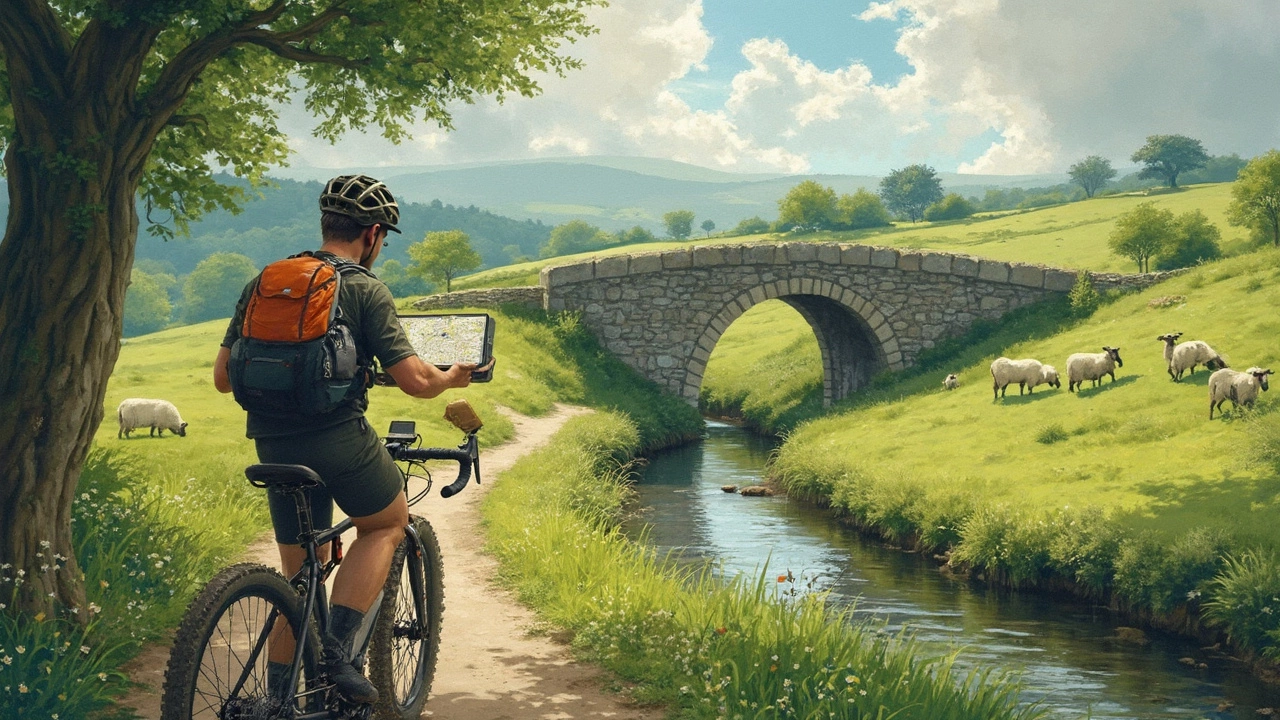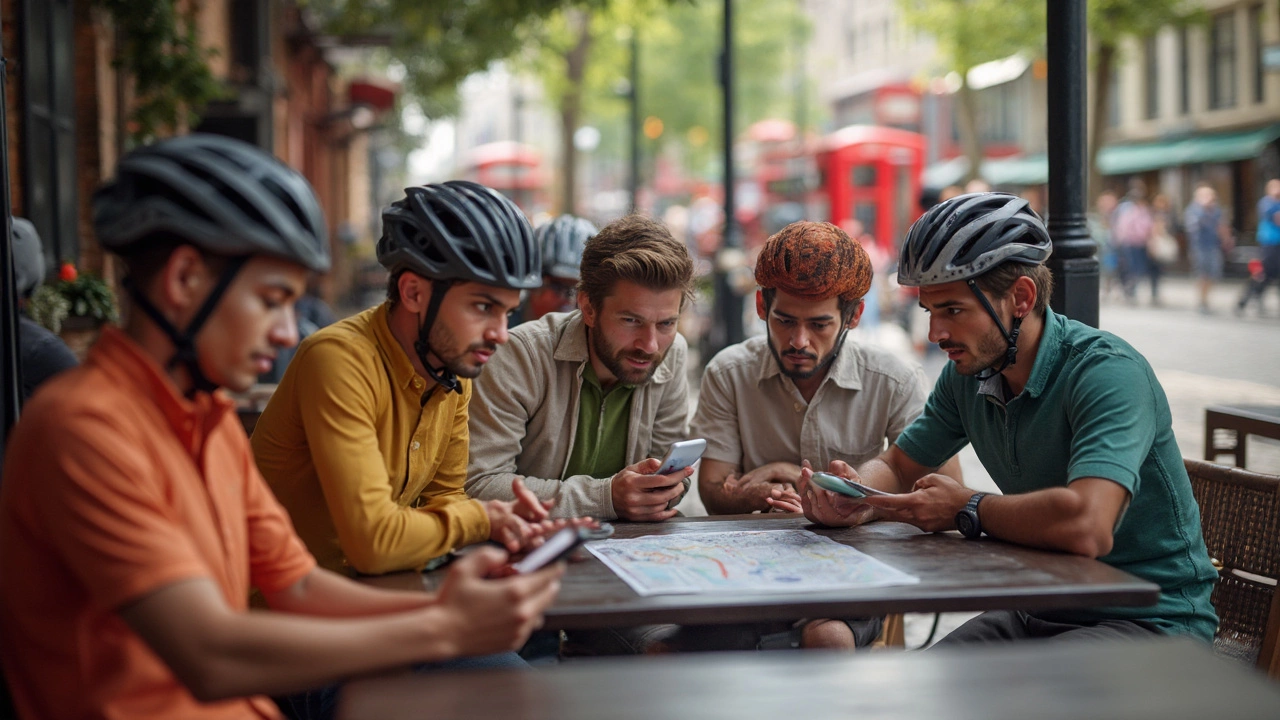
Cycling April 3, 2025
How to Use Google Maps for Bike Routes
Ever tried planning a bike trip with Google Maps? It's a bit like unlocking a hidden feature. Google Maps is not only for drivers and pedestrians; cyclists benefit a ton from it too. Imagine having a tool in your pocket that can find the safest, most efficient paths for your ride. Let's dig into how you can use it like a pro.
First thing, just pop open Google Maps on your phone or computer. The little bike icon is your new best friend. Tap on that, and Google Maps will switch to showing bike-friendly routes. It's like having a GPS specifically tuned to pick out paths that won’t get you run over by a bus.
But not all bike routes are created equal. Some paths take you through scenic parks, others shortcut through busy intersections. If you're looking to avoid the traffic warfare, toggle on the 'Avoid Highways' option. Trust me, your stress levels will thank you. And if you're pedaling through unfamiliar areas, the 'Explore Nearby' feature is great for finding nearby cafes or repair shops, just in case you need them.
- Getting Started with Google Maps
- Choosing the Best Bike Routes
- Avoiding Traffic and Finding Safe Paths
- Customizing Your Ride
- Using Offline Maps for Biking
- Tips for a Smooth Ride
Getting Started with Google Maps
Okay, so you've decided to start using Google Maps for your biking adventures. Smart move! First things first, make sure you've got the app installed on your phone. It's available on both iOS and Android, so no worries there.
Once you’ve got the app open, you’ll want to type your destination into the search bar. Easy, right? Now, look for that little bike icon. It’s usually in a row with car, public transport, and walking options. Tapping it turns the map into bicycling mode. This adjusts the routes to highlight paths using bike lanes, trails, and roads where cyclists are welcome.
Now, when you're scanning through the available routes, it highlights the estimated time it’ll take you to reach your destination. And here's the cool bit—these estimates consider elevation, traffic, and type of path. Google Maps even considers bike lanes into those times, so you're not just getting a number, you're getting an informed estimate.
For a more in-depth look, tap on the route itself. It'll give you a bird’s eye view of the journey ahead, complete with turn-by-turn directions. Handy, huh? If you're someone who gets lost easily (like me when I'm in new spots), don't fret. The live navigation feature is amazing. Just pop your phone into a bike mount, and let Google Maps guide you with audio instructions.
If you’re the kind that likes to double-check everything, there's the street view option too. Use it to get a real look at the paths or street corners. This can be super helpful if you're heading somewhere for the first time.
Some of the most common routes even show helpful info, like the steepness of a hill, which is like having a friend yell, "Hey, take it easy here!" This kind of local insight can make a big difference to your ride.
Choosing the Best Bike Routes
So, what's the secret to picking the perfect bike route on Google Maps? It all starts with understanding your needs and knowing what to look for. Are you in the mood for a leisure ride, or is it all about speed? Your goal influences the route you choose.
When you fire up Google Maps, it's already set to consider elevation, terrain difficulty, and bike lanes. But here's a handy trick: always check the 'Layers' option. This will highlight bike lanes and trails in green, showing you clearly designated paths that are safer and usually quieter—making them ideal cycling choices.
Another cool feature is to set waypoints. If there are specific places you want to pass by, like a bakery that has your favorite doughnuts or a friend's house, just add them to your route. You can easily customize your journey by dragging your path on the map to include these stops.
To spice things up, use the 'Popular times' tool. It reveals when the routes are less crowded, helping you dodge rush hours or packed areas. Plus, if you want to explore the area without getting lost, downloading maps for offline use is smart. This ensures you don't get stuck staring blankly at your map app when you’re out of network coverage.
And don't overlook community feedback. User reviews around a particular path or area can give you insider info on what to expect—from hidden gems to places to avoid. In essence, Google Maps is packed with options to guide you to not just any path, but the best possible ride every time.
Avoiding Traffic and Finding Safe Paths
Nobody wants to be caught in the chaos of traffic while cycling. The key is to use Google Maps to its fullest. Once you're in biking mode, keep an eye on the map's green lines. These lines indicate dedicated bike trails, which are your best bet for a safe, relaxing ride.
To steer clear of bustling streets, always check the 'layer view' on the map. You'll see layers for biking routes, where 'dashed green lines' show separate bike paths, and 'solid green lines' represent bike lanes along the road. Committed to avoiding traffic? Stick to those dashed greens whenever possible.
Google Maps is not just about the visible paths. The 'Traffic' option helps too. It shows real-time traffic conditions, so you can reroute if you're about to wade through a jam. Orange or red on the map is your cue to find an alternate route.
Additionally, you can set the app to inform you about elevation changes. If you're not in the mood for uphill battles during your ride, use the elevation feature to plan accordingly. Just tap on the route details to see elevation charts before you hit the road.
For those who like data, here's something cool: a recent study showed that cities with dedicated bike lanes experience a whopping 50% reduction in bicycle accidents. That's a stat worth considering when choosing your path.
| Route Type | Feature | Recommendation |
|---|---|---|
| Dedicated Bike Trails | Buffered from traffic | Ideal for beginners |
| Bike Lanes | Along streets | Watch for cars |
| Shared Lanes | Mixed traffic | Use with caution |
Always remember that visibility is as important as your route choice. Wear bright clothes and use a white front light and red rear light at night. It's all about making the ride safe and enjoyable.

Customizing Your Ride
So, you’re ready to make your bike trip uniquely yours. The beauty of using Google Maps for bike routes is that it lets you tweak your journey to fit your style and needs. Whether you’re out for a leisurely cruise or zipping through town, customizing your ride makes all the difference.
First up, think about waypoints. Google Maps doesn’t just give you point A to B directions; you can add multiple stops along the way. Want to grab a coffee, visit a park, or detour through a less hilly section? Tap on the route line and drag it to hug those spots. Easy.
If hills make you sweat bullets, here’s a tip: check the elevation details. When you pick a route, Google Maps shows an elevation graph that lets you see exactly where those grueling climbs will hit. If climbing isn’t your thing, choose a flatter path using this feature.
Customizing also means being ready for the unexpected. Downloading maps offline is a lifesaver if your internet decides to take a break mid-ride. Just tap 'Download Offline Map' in the menu, and select the area you'll be cycling through. Now you're set, even when signal’s a no-show.
Let's not forget about real-time traffic updates. Turning this on helps you avoid newly formed roadblocks or construction work. Just like that, Google Maps updates your route to skirt around any surprises.
For those who love a sprinkle of geekiness, dive into the cycling metrics available on Google Maps. It’s a fun way to track your actions; distance cycled, estimated calories burnt—perfect for those who like stats with their saddle time!
Mix and match these options to make each ride an adventure. Every ride can be as unique as you want, ensuring you get the best out of your biking experience.
Using Offline Maps for Biking
Getting lost with no internet? It's every cyclist's nightmare, but don't sweat it! Google Maps has your back with offline maps, even when you're venturing off the grid. Here's how you can make sure your bike routes are foolproof even without a signal.
Start by loading up Google Maps while you're still on a Wi-Fi connection. Search for the area you’ll be cycling in and tap on the specific location. Look for the 'Download' button—it’s like saving your navigation sanity for later. Once you download, you'll have access to all the necessary maps and routes, even in the middle of nowhere. It's like having a paper map, but way cooler.
To save storage on your phone, only download the sections you really need. Trust me, zoom in and avoid loading up your phone with the entire state! Also, update these offline maps regularly. Google updates its routes often, and having the latest info is key for safe cycling.
- Open Google Maps and search for your ride region.
- Tap on the location at the bottom of the screen.
- Select 'Download' to save the map for offline use.
Offline maps are great, but remember, without live data, you won't get real-time traffic updates. So, doing a little research on usual traffic patterns beforehand or planning your ride during less busy times can save you from headaches.
Whether you're exploring new trails or just trying to get downtown efficiently, using offline maps with Google Maps makes navigation a breeze. Next time you're biking, experiment with this feature. It's like giving your phone a knack for being a trusty navigator, no matter where your pedals take you!
Tips for a Smooth Ride
Getting into biking, especially when you're plotting your bike routes on Google Maps, can really be a breeze if you have some handy tricks up your sleeve. With these tips, your cycling trips can be not just safe but also super enjoyable.
First off, always check the weather before heading out. Rain might seem like an adventure, but slippery roads are a bike's worst enemy. Use the weather layer on Google Maps to get a sense of what to expect. You don't want to get caught unprepared.
Next, gear up your bike wisely. Carry a patch kit for flats—because let's face it, nobody plans for a flat tire, but being ready for it can save the day. Also, a quick check-up of your brakes and lights could be the difference between a smooth ride and an emergency stop.
Another sweet tip is utilizing the 'Save Offline' feature on Google Maps. Battery dying halfway through your trip? No problem if you have the map saved. It’s the digital backup you didn’t know you needed.
And don't underestimate the power of some good snacks and hydration. Energy bars and a water bottle are total game-changers, especially on longer trips. Bonking is real, and it’s no fun. Stay fueled and hydrated to keep those pedals turning smoothly.
Lastly, keep an eye on your pacing. If you're planning a longer distance, it's tempting to just go full throttle, but remember to pace yourself. Take breaks as needed—grab a coffee or enjoy a park along your route. Cycling is as much about the journey as it is about the destination.
By using these tips, you're setting yourself up for a much more pleasant and enjoyable biking experience, no matter where Google Maps takes you!




